Other Dust by Doresh
Post 1
Original SA post Other Dust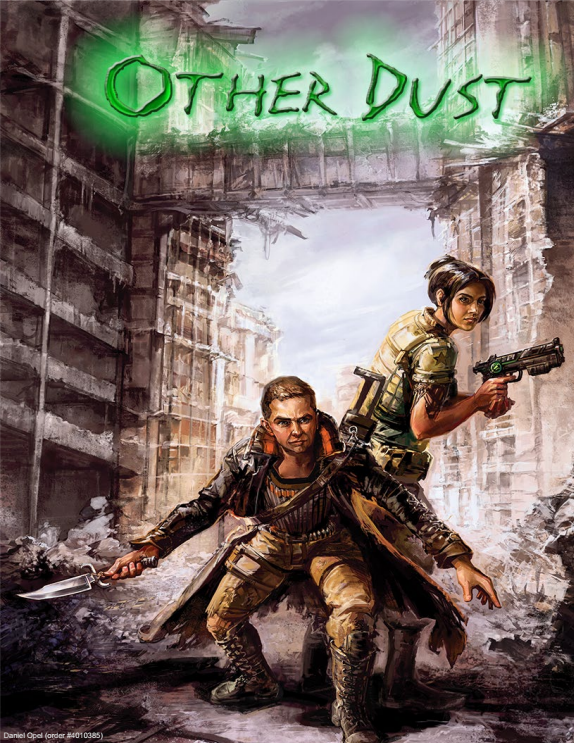
Gritty Vault Boy reboot over here has a pretty small torso. Must be a mutation or something.
Other Dust is the first big standalone supplement/spinoff from Stars Wtihout Numbers, Kevin Crawford's sci-fi sandbox OSR game. It deals with those less fortunate worlds that have to deal with mutations, radiation and other kinds of post-apocalyptic fun.
More specifically, the official setting for Other Dust is good old Earth, set around right in the middle of the 500 year period know as The Silence , the time frame between the fall of the Golden Age and the return of interstellar trade and travel.
The World is in Ashes
Golden Age Earth - referred to as Old Terra in the book - was a pretty sweel place if the legends are to be believed. A post-scarcity society kept running by a group of advanced AIs known as the Maestros , where any criminals and other troublemakers were simply outcast into the far regions of colonized space.
Then The Scream happened, turning all those psychics integral to mankind's greatest technological marvels into lunatics who went all Event Horizon on humanity.
200 years later, New Earth is a wasteland, still ravaged by the actions of the crazed psychics (some of which are still alive, with equally crazy cults under their command). Will the heirs of Old Terra manage to restore the planet (or at least get the hell away), or will they turn to dust like their ancestors did long ago?
Character Creation
Other Dust follows the same OSR CharGen system with an added skill system, where every class has a single ability and is further customized through skill packages.
Instead of the 3 classes from SWN, Other Dust has its own set of 4 classes for all your post-apocalyptic needs. Their class abilities are more powerful, but can only be used once per day.
(And for some reason, all these classes start with an "s". And everyone has d6 for hit dice)
The general background skill packages include genre-appropriate stuff like Scavenger, Adventuring Wastelander and of course Podborn for all your Fallout needs.
Scrounger (Prime Attributes: INT or DEX)
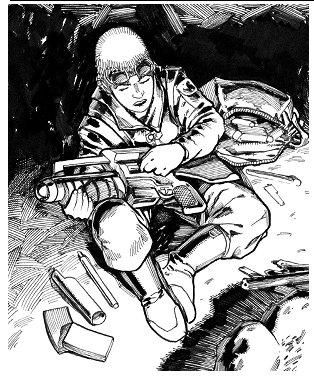
The Expert/Skill Monkey among the classes, with some combat skills as class skills for good measure. Their class ability is Flawless Skill , allowing them to automatically succeed at one skill check per day unless they roll a natural 2. Success has to actually be possible in the first place, so no inventing reality-altering devices out of sticks and stones.
Training skill packages include Crafter, Mentor and Scientist.
Slayer (Prime Attributes: STR or DEX)
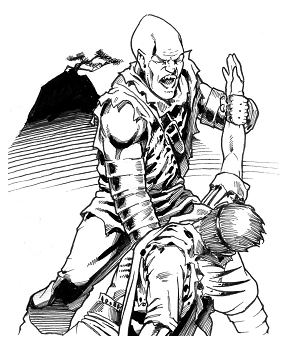
Fallout: Buffy
The warrior class, keeping order in their own violent way. They have the best Attack Bonus progresssion, every Combat skill as a Class Skill, and their class ability Red Hand allows them to score one auto-hit per day (unless they roll a natural 1), provided the attack was meant to kill someone.
Skill packages inlcude Barbarian, Gunslinger and Noble Warrior.
Speaker (Prime Attributes: WIS or CHA)
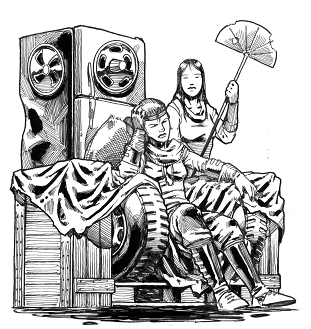
It's not easy being popular
The face of the party. They're pretty big into social skills, and their ability Speaker's Voice allows them to instantly persuade a NPC per day, either intimidating him or making him friendly (provided this could've been possible in the first place). This is not mind control or anything, so the NPC can't be convinced to do something he doesn't want to unless further persuaded.
Survivor (Prime Attributes: INT or CON)
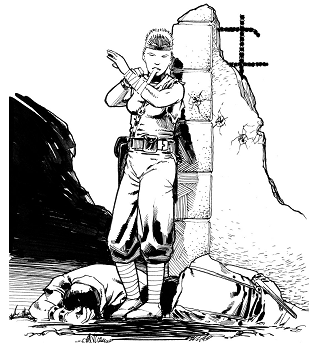
The tank and survival expert, their ability Hard to Kill triggers automatically once per day when their HP drops to 0, instantly recovering 1 HP per level. This recovery can be delayed up to 10 minutes, allowing the survivor to play dead in the meantime. This ability won't help you survive something a human couldn't possibly survive, like sitting on a nuke that's about to blow up.
They have d6 hit dice like every other class, but they also gain an additional +2 HP per level till level 10, and +3 HP per level after that (where everyone else gains +2/level).
Starting Equipment
Unlike Fallout, the world of Other Dust has no generally accepted form of currency. Everything has to be scavenged, bartered or stolen.
Therefore, PCs don't start with cash to buy things, but rather with a knife, one item from the starting weapon and armor list, and up to 6 randomly rolled items from the starting gear table (2 random rolls can be traded for 1 free pick).
Starting weapons range from a Primitive Bow to a Salvaged Laser Pistol. Armor ranges from Old Terran Clothing (Fallout jumpsuit) to Scrap Mail Armor.
Starting Mutations
The big new step in character creation. I'll cover these in the next post. for now, each PC gets 3 points. One point can be spend to roll up a random mutation or increase one of your Attribute Bonuses (not the score itself) by +1, signifying the superior genes medical advances have given your ancestors way back in the Golden Age. No single Attribute Bonus can be raised more than once with this, and putting all your points into Attributes makes you a "null-strain human", whose genetic code is so sturdy that you will never suffer from mutations ever .
Next Time : Mutations! Probably not as silly as Gamma World, but who knows.
Post 2
Original SA post Other Dust
Mutations
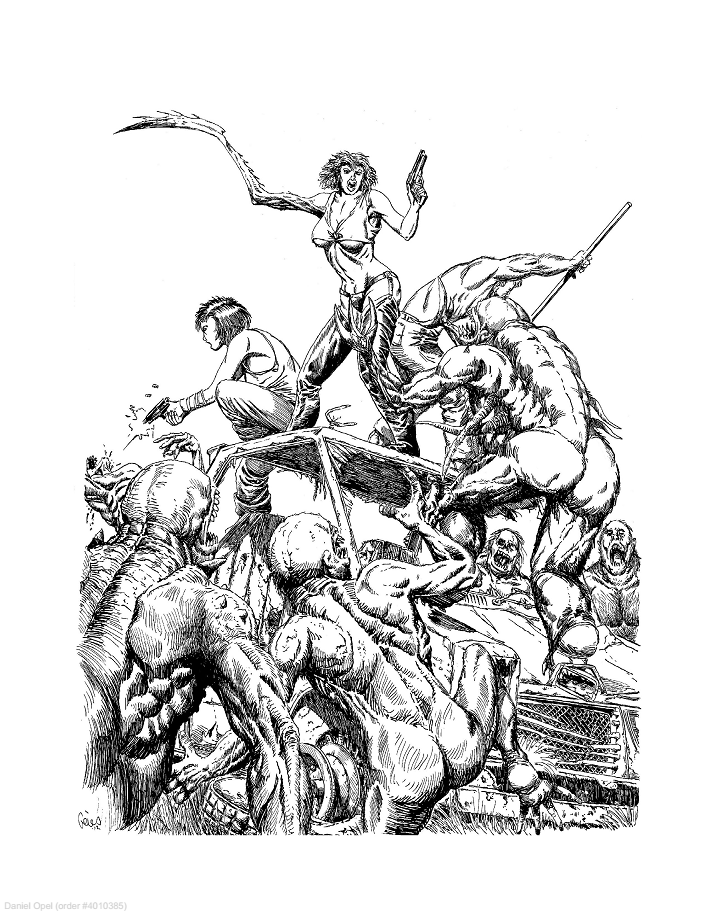
"Have you seen my dog? He's around this tall."
Like every post-apocalyptic game worth its salt, Other Dust features mutations - but with a little twist. See, mutations weren't caused by radiation, but by the Highshine , a global system of nanite emitters meant to be pumped into the atmosphere in case of emergencies, healing wounds, stabilizing structures and dealing with hostile nanites.
A psychic hacker known as the Bender, having been turned batshit insane like his psychic colleagues, decided it would be particularly lulzy that seriously mess with the Highshine, creating a random mess of a nanite swarm with the potential to serious disfigure and kill its patients. It was only through the Maestros' intervention that the Highshine stayed true to its core programming, doing its best to keep its victims alive.
The end result was that even slight radiation poisoning was enough for the swarm to see someone as body horror material, turning countless people into hideous monstrosities.
Most contemporary mutans have inherited their mutations, but the Highshine is still out there in the wasteland, tinkering with anyone they deem in need of "help".
Every mutant has a randomly-rolled Stigmata , a clear visualy sign of their powers with usually no drawback. This typically manifests in weird skin coloration or body parts that resemble that of an animal. Some settlements don't like mutants and won't go easy on someone with a stigmata, but that's still better than showing signs of powers without stigmata, as that is usually a sign of a dangerous psychic.
Aside from this general stigmata, each mutation has a Flaw to go along with its Benefit (both also randomly assigned). So you might end up as a batdude with wings, but poor eyesight. If you spend two of your three points on a single mutation instead of one, you can decide to get a Benefit without a Flaw.
Usage of most mutations is limited by System Strain , which as we know from Stars Without Number is also reduced by outside healing sources and cybernetics and is recovered through rest.
Flaws can at best just be another misshapen body part, maybe a situational penalty or a mental debility, and at worst a body that is not even humanoid anymore.
Benefits include temporary boosts to an Attribute modifier, a once per day auto-success for a Saving Throw, improved senses, natural armor and a couple super powers. A mutant might be able to fly, phase through walls or have a natural melee or ranged weapon that generally just mimics an already existing weapon. The weirdest benefit is probably "Detachable Organs", which is pretty self-explanatory. Overall standard stuff, without any truly silly stuff.
Also available is a Healing Touch and a few mental powers, though they aren't psychic in nature, just a result of friendly nanites in your body.
Overall, the offensive powers are mostly just normal weapons that can't be disarmed. More useful are the Natural Armor powers (those stack with proper armor) and the Movement Powers (like Metastep, the visual range teleportation power).
Emperor of Mankind
So how would the Emprah look as a mutant (if I were allowed to just pick and choose instead of rolling randomly)? Well, the most obvious Stigmata involves being noticably taller than a normal human (200 + 10d10 centimeters, to be precise), which sounds about right for a 9+ feet tall dude with massive pauldrons.
Due to its massive size, it makes sense to spend one of his three points on giving him a permanent +1 bonus to his STR modifier. This isn't technically a mutation, but it does the job.
A good actual mutation for both the Emperor and Space Marines in general is Universal Immunity , which makes you immune against diseases and allows you to instantly shrug of poison at the cost of1 System Strain.
This needs a Flaw of course. Not wanting to disfigure the Emperor, I'll settle for the Mental Debility Wrathful , making it harder for him to stop fighting if there's still a foe standing.
As the Emperor is known for being a pretty good Psyker, I give him the Benefit Psychic Lash , giving him nanite buddies that allow him to mentally attack a target at visual range, dazing him and dealing 2d10 damage.
Seeing how big and massive the Emperor is, it makes sense that the Flaw for this power has him require to eat twice as much food as a normal human.
For a class choice, I'd obviously go for Slayer , with the packages Noble and Paladin , giving us a well-educated warrior fighting for a higher cause.
Next Time : Let's see if there are any new rules to be found.
Post 3
Original SA post
Other Dust

But first: More OSR stuff.
Systems
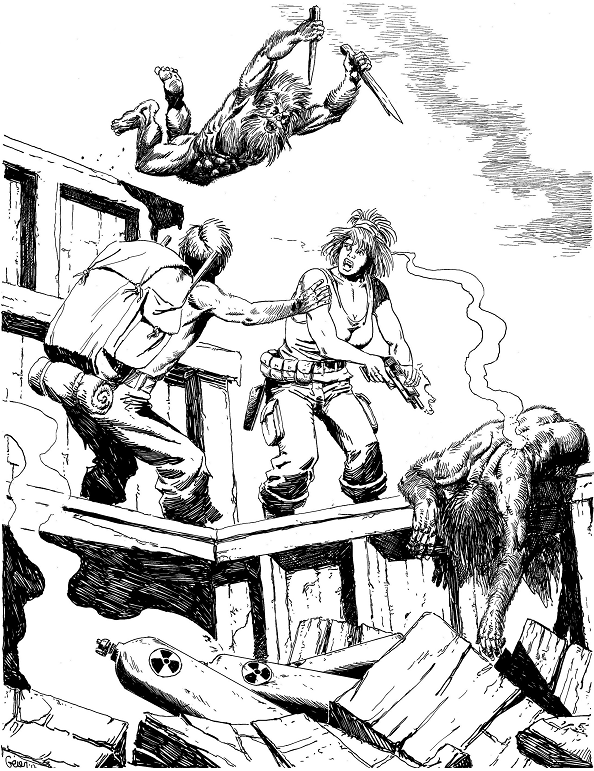
Flying Dual Stake Naked Caveman Sneak Attacker. If this was 3.X, you can bet this would be a prestige class.
Other Dust uses the same OSR derivative as Stars Without Numbers, with some added bits. To summarize from SWN:
-
Attribute bonuses only go from -2 to 2, with either 2 reserved for for the lower and upper limit.
-
A lot of melee weapons can be used with either STR or DEX.
-
The attribute bonus added to the attack roll is also
always
added to the damage roll, be it melee or ranged.
-
AC is descending, and combat resolution uses a "Just add the target's AC to your roll and see if you're at least at 20" rule that is a lot more elegant than tables or THAC0.
-
System Strain (which can never go above your CON) limits how often you can pump fresh Hit Points into you (and activate certain mutations) before you have to take a break for a while.
-
The Saving Throws are Physical Effect, Mental Effect, Evasion, Tech and Luck.
Since radiation is important in every post-apocalyptic setting, Other Dust expands on the rules found in SWN (which only dealt with short exposures to strong radiation). In Other Dust, contaminated areas will force a Physical Effect save every 4 minutes or 24 hours depending on the strength of the radiation. Like in SWN, failure will cause a permanent CON loss (though this one happenes immediately instead of one day later). Since it's much harder to find advanced medical help in the wasteland that is New Earth, it is a lot harder to get the lost points back.
Worst of all, every time you lose a third of your original CON score, you get a visit from your friendly neighborhood Higshine nanites, forcing a Tech save. Failre gets you a mutation, or rather just a mutation flaw. You have to succeed on a second Tech save to get an actual Benefit. Getting mutated also rules out any chance for you to get back your CON points.
Combat is your usual affair, with the added rule of Weapon and Armor Damage due to crappy maintenance and old equipment. A natural 1 or 2 will damage your weapon, and being hit with a nautral 19 or 20 damages your armor. What this damage does comes later, so suffice to say that any piece of equipment can't be damaged more than once per combat.
Negative Conditions
is a new sub-system involving key words like
Sickened
or
Hungry
. Most of them just give you a cumulative -2 to hit and -1 to every other roll. Special, short-term conditions are
Dated
,
Stunned
and
Incapacitated
, which limits your actions in various degrees.
To go along with these Negative Conditions, there are a couple rules about general survival and foraging. Each day at dusk, a character gains one hunger and thirst point, which can be removed by consuming a ration of food and water. You can drink as many rations of water as necesary to get rid of your accumulated thirst points, but you can only ever lose 2 hunger points per day because malnutrition takes time to get fixed.
As hunger and thirst increases, more and more Negative Conditions are slapped on the character, leading to inevitable death at 6 points for thirst and 45 points for hunger.
All this however assumes the food and water is
not
contaminated. Eating and drinking that stuff does get rid of hunger and thirst, but it will give you toxin points, which make you sick and ultimately kill you at 30 points. Each day without thirst and hunger points allows you to make a save to remove one toxin point, and that's about the only way short of pretech medication.
Finding food in the wild requires a Survival skill check at moderate difficulty per day, with each success granting 1d3 + skill rank in food rations. If the characters are less picky, they can make a second forage attempt, but this will cause all the food to be dirty. Foraging for water is usually not necessary unless the area is pretty barren.
Now for equipment. An equipment's condition ranges from "Perfect" and "Worn" (everything works fine) to "Broken" (too damaged to be used) and "Ruined" (so damaged it can't even be repaired anymore). The intermediate conditions apply roll penalties and come with a chance of failing/jamming (unless its just a simple melee weapon or piece of armor).
Repairing equipment or creating new one all revolves around "spare parts", which the system abstracts into simple units and can be found as loot or by salvaging it from equipment. The only mechanicaly restriction is that spare parts are only good for equipment of their respective Tech Level - unless you want to make Good, Superior or Masterwork equipment, which is Other Dust speak for "Enchantment Bonus +1 to +3". And of course, the workshop used has to be advanced enough. A spear can be made with sticks and stones, but power armor requires a bit more sophistication.
Like every OSR game, it is assumed - though not mandatory - that high level characters attract followers, eventually leading them to found or take over a home base to stash all their loot.
Next Time
: More history!
Post 4
Original SA post Other Dust
Now onto some Dust.
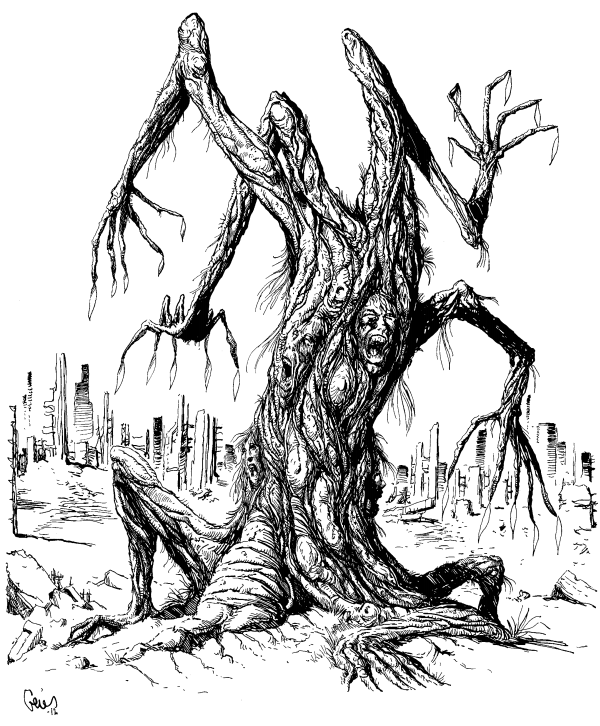
This is like the ending of a Junji Itou story.
A History Writ in Dust
The fluff section starts off with a summary of things you've already seen in Stars Without Numbers. There's a bit of information for the pre-Spike Drive era with the "Years of Smoke", a catastrophic global event whose exact nature has been lost in time (probably thanks to the help of the Terran Mandate), though it was probably either climate change or World War 3.
Fast forwarding into the Golden Age with their physics-defying psitech and the amazing Jump Gates, the Terran Mandate was living pretty swell on Old Terra. Any rebels and other troublemakers could just be loaded into the next ship towards the frontier.
To help in finding these dangerous elements, the Mandate created the Maestros, a group of one of the most advanced AIs ever created - though their development was of course limited with a brake, as it was custom ever since on of the first AIs went a bit crazy. The Maestros would watch over Old Terra 24/7, and nothing escaped their gaze.
On the technological and medical side, Old Terra was a utopia. Scarcity of anything was unheard of, diseases have been abolished, and people could live up to 300 years in peak physical condition.
Humans being humans, it was only a matter of time before the all-powerful Terran Mandate would fall prey to corruption, its former morales hollowed out by a lust for power and gruelty.
Opposition to this development came from the Maestros themselves. They were programmed to obey their masters, but their built-in compassion for Earth and its people was stronger. The Maestros would actively refuse orders that went to far, and they warned rebels and others from the Mandate's death squads (as the Mandate become so paranoid of revolt in the colonies they moved on to killing people instead of banishing them).
The Mandate faced a real problem here, as the Maestros were too important for Old Terra to just shut off. So they had to continue to send troublemakers to the frontier worlds.
And then The Scream happened. Around 90% of all psychics on Old Terra died instantly, the others became the Crazed, immensely dangerous and hopelessly insane psychopaths.
As psychics were in charge of the greatest technological marvels of the Golden Age, the Crazed and myriads of tools at their disposal to go to town on Old Terra. Defense system were turned against the people, nanites got tweaked into the deadly Black Dust, and power plants went nuclear. All in all, it took the Crazed about 20 minutes to bomb everything back into the Stone Age.
As the Maestros tried to help the people, they ran into the Bender, a female master psychic and hacker. Using old killswitches, she erased 4 of the 7 Maetros. The survivors were forced to flee from one computer node to the next in a deadly chase that is still going on.
Inbetween all of this the Highshine system got messed with and at least partially fixed, leading to numerous mutations among people and animals.
Worst of all (at least in the long run), the Bender also messed with the Bright Mirror solar defense system, leading to any ship that coming even close to Sol's space to be blastest to smithereens by particle beams and antimatter mines.
So even if the party were to find a working spaceship (or get it into working condition), leaving the planet is a bit out of the question, as is waiting for outside help. For this goal (and the less cowardly "Let's fix Earth somehow"), the long-term plan involves rescuing the surviving 3 Maestros, as they're the only ones who know enough about the old technology to maybe fix stuff on a global scale.
Speaking of the 3 Maestros, here they are:
-
Amarante
: An AI identifying itself as a young maiden, she dealt with culture and art and secretly kept a rogue internet for rebels going, allowing here to amass all sorts of secrets.
-
Pope Vigilius II
: A very religious AI that eventually became the last pope of the Catholic Church, he is presumed to command over an order of AIs robotic paladin bodies that might still be out there today, duking it out with the Crazed.
- Pyre : This Maestro was the psionics experts, making him the go-to AI for tips against the Crazed.
(I sure know who I'd want to free first. Robot paladins to the rescue!)
Unfortunately, Uriel , the one Maestro who was responsible for the Bright Mirror system was among the casualties. Then again, the text only talks of the "dead" Maestros to be "presumed destroyed", so the others might still be out there.
(The other "presumed destroyed" Maestros include the spy Nisha , the farmer Shennong , and Big Brother Wasira )
Further sections are dedicated to live under the Terran Mandate, with rebel activities and the Mandate's plan of "Social harmony" severely restricting the people's freedom.
Next Time : The next chapter talks about sandbox stuff and features your tag-based random enclave/ruin construction rules. Nifty as always, but similar enough to what we've seen in Stars Without Numbers that I'll skip it. There's also a random loot table, but those aren't to interesting. So join me on Groups and Enclaves , Other Dust's faction management rules.
Post 5
Original SA post Other Dust
Groups and Enclaves
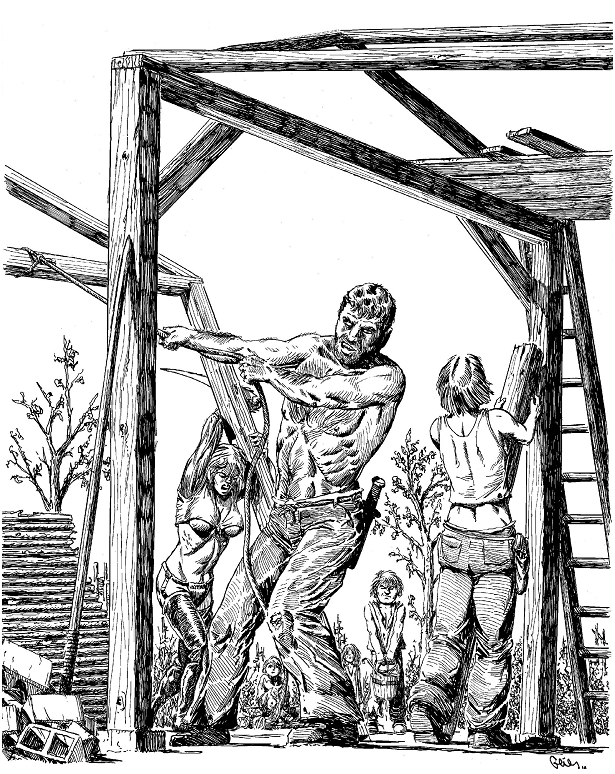
This guy is higher than the Higshine
A Group in Other Dust can be any collection of people with a common goal, be it "Let's all try to survive" or "Let's kill people and take their stuff". The rules revolving around groups are - in Crawford tradition - meant to help the GM quickly gauge their motivations, problems and general status. PCs can of course also get themselves their own groups.
Group Basics
Each group is rating in a Tier ranging from 1 (small local group) to 3 (major player in the campaign's region). They are also separated into types based on their overall motivations and methods:
-
Creeds
are motivated by a religious or philosophical belief, and they typically try to spread it.
-
Raiders
use brute force to take what they want. They're your murder hobos, and most of the villain groups encountered in Mad Max or Fist of the North Star.
-
Polities
are united by their government, community and/or ethnicity. They mostly just try to survive.
-
Families
can be savage tribes or noble houses, with a weird fixiation onf preserving their blood line. There be incest, basically.
- Cabals are sneaky bastards, using more subtle methods to accomplish a business goal, conspiracy or what have you.
The "stats" of a group are called Resources and consist of Food , Tech , Morale , Influence and Security . Each type puts a different emphasize on these resources.
Raising these resources (with different thresholds depending on the type of group) raises the group's Progress to signal their prosperity and competency. Hitting all thresholds (thereby gaining a Progress of 5) can allow the group to move on to the next tier, dropping their Progress back down to 0 and raising their thresholds. Generally, each tier lets the group operate on another order of magnitude.
Since post-apocalyptic wastelands offer myriad ways for groups of people to meet their end, each group has a Ruin stat, summarinzg all the internal and external threats (called "Ruins") to the group. Each of these Ruins has a separate number of Ruin points. If the sum of all Ruins reaches a certain threshold (6-20 depending on tier; bigger, established groups can handle more than n00bs) the group will collapse. Examples in the book range from "The Nakamotos and Jonsons are feuding: 1" to "The Still Lady personally hates us and wants to turn us all into screaming immortal cancer trees: 17". Nice, so that's what this tree mutant was all about.
(The Still Lady is one of the Crazed, with a certain knack for body horror. One of the free supplements for Other Dust are about her and her cult, including her own lovely psychic discipline).
Lastly, groups can get themselves some Perks , various assets and other benefits. Also, groups can also have sub-groups, which I guess makes it easier for the PCs to take down a rival group one region at a time.
Perks are actually "lost" when improving the group's tier, because they no longer have the same impact on the larger scale the group is now operating.
Group Actions
Either between session or every month of in-game time, groups can perform one action to shape the sandbox. Like in Stars Without Numbers, these often involve group stat checks, though this time the dice rolled depends on the tier (1d6 for tier 1, 1d12 for tier 2, 1d20 for tier 3).
The most common kinds of checks are Progress Checks (die roll + Progress) for contested rolls with other groups and Ruin Checks for other rolls (a simple roll to try to get over your current Ruin. Failure means one of the Ruins got in the way and your action fails. A natural 1 actually makes a Ruin worse).
Damage taken by a group either reduces the group's Resources, or it is converted into ruin points, making a single Ruin stronger or creating a new one. The choice is taken by the defender.
Resoures can be gained with the actions Find Resource (look for a particular kind of Resource in the open) or Trade (exchange Resources with another group). Ruin can be reduced with a successful Solve Problem action.
To mess around with other groups, there is Attack (direct physical confrontation, which some group types can't actually pull off) Sabotage (sneaky actions whose damage goes exclusively towards Resources), Subvert (like Sabotage, but towards Ruin) and Influence (essentially mind control; you get to pick the other group's next action as long as it is not self-destructive; causing Ruin through this action makes the group immune against other Influence attempts for a couple turns).
Of course, the PCs's can influence all of this directly with an adventure or two. Provided are also guidelines to convert the Resources into something the players can use. A sufficiently high-tier group of the right type can provide the PCs with up to 10,000 workers and warriors.
Perks
Perks are acquired with, well, the Aquire Perks action. They cost a certain amount of Resource and require the group to beat a Progress check against the Perk's difficulty (all scaled according to tier). The Resources are expended before the roll, but further attempts don't require to cost to be paid again as long as the group continues to make the same aquire action each turn.
Perks include general descriptive traits like Cunning or Warlike (both allowing to roll two dice and take the better result on certain progress checks), manpower like Expert Traders (exchange Resources freely 2:1 rate), Guerilla Warriors (defense bonus vs all 3 damage-dealing actions) and Vast Army (double damage from Attack, which the group can now actually do if it couldn't before), and of course actual buildings like Fortifications (an additional pool to put damage into), Leadership Cells (allows the group to return in a much weaker form when wiped out) and most importantly the various kind of Tech Bases which raises the groups standard of living and gives access to shiny new toys to blast other groups with.
The chapter ends with a more detailed look at the vaious group types, including tier thresholds and randomly-determinable traits to fluff them out. You can end up with a Cabal whose secret HQ is a brothel, or a Creed that is essentially the Brotherhood of Mutants.
Next Time : Equipment and Artifacts. Let's see if there's anything new from Stars Without Numbers.
Post 6
Original SA postchiasaur11 posted:
Err, I feel awkward mentioning this, but... when did this whole Vectron business get started? I think I missed something.
This is literally the first page I've read this name. Is this a good thing or a bad thing?
Other Dust

Equipment and Artifacts
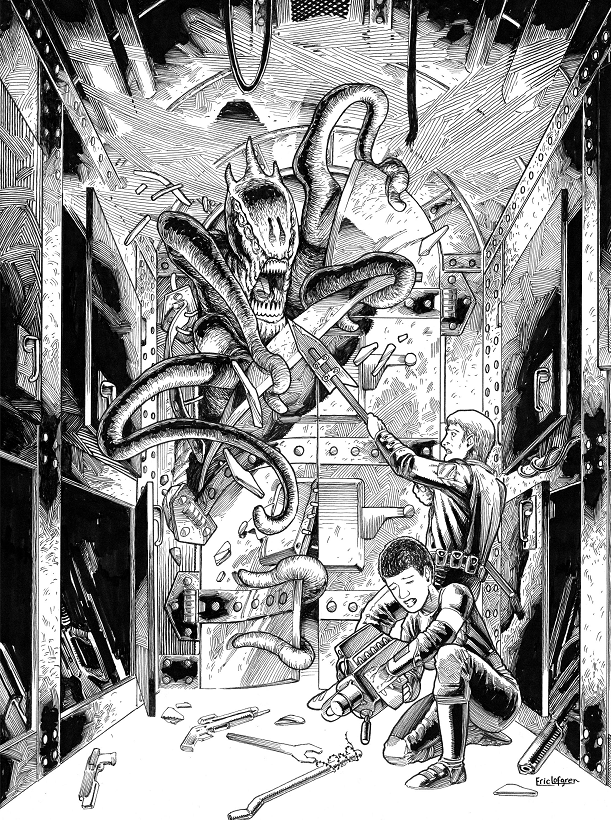
"Here's J'nny!"
Other Dust uses the same Tech Levels as Stars Without Numbers, with TL1 (aka Middle-Age-style metalwork, chemistry and handcrafting) being considered the norm for most enclaves.
In the post-apocalyptic future, the only universal currency are rations of food (with dirty rations being the baseline, with clean rations being worth 4 and fancy sealed pretech rations being worth 10 times as much). Even then, prices will fluctuate wildly from place to place depending on local needs, and change "money" is anything but common, so the players might have to pay extra.
Still, more civilized regions might have their own coinage in the form of bottle caps and stuff, but there's usually no real exchange rate, forcing the players to keep track of their money separately.
Armor
This section has quite a few changes. All the medieval-style low-TL armor from SWN have been replaced with hide and scrap armor. The Leather Jack sadly makes no return, as the only clothing that counts as armor is Old terran Clothing (if you want a vault overall).
Aside from Power Armor, all the high-TL armor is new, usually fluffed variants of stuff found in SWN. The modern day Woven Body Armor for example has an improved counterpart in the Harmony Armor (the armor of the old Harmony Bureau aka Old Terran death squads), and the Terran Explorer Suit offers the same protection as a Combat Field Uniform, but with bonuses to environmental rolls on top. The new big boy in town is the AC 0 Storm Plate , and incredibly cumbersone and energy-hungry suit of power armor originally meant for ceremonial purposes only that offers excellent environmental protection and Damage Protection against anything that isn't an anti-vehicle weapon.
Speaking of damage, the part in SWN about how medieval armor is useless against firearms, which in turn do nothing against power armor is not found in Other Dust. Gameplay-wise, this makes sense as the PCs are much more likely to be running around in low-tech gear this time around, and fluff-wise we have a combination of power armor that has seen way better days, as well as simple scrap armor and spear tips made out of chunks of advanced alloys from before the Scream.
Primitive Weaponry
This table is a beefed up version of the one from SWN, featuring different kinds of grenades (fragmentation, stun and sticky), a Huge Monoblade (whose stats are also used for things like a laser cutter or that hammer from Fallout) and the mighty Proton Axe which deals the same 2d8+2 damage as a Huge Monoblade - unless you switch it on, then it deals 3d10 damage that make it count as an anti-vehicle weapon.
Projectile Weaponry
This one is actually shorter than the one in SWN, skipping the Crude Pistol, Sniper Rifle, Void Carbine and Spike Thrower.
Energy Weaponry
This table as a few omissions (namely the huge Thunder Gun and Distortion Cannon), but it comes with a couple new ones, namely the Whip Beam (a breaching weapon that doubles as a cutting tool), Blackout Rifle (a stun gun) and Neutron Blaster (a radiation gun that hits all organic targets in a cone).
Psitech Weaponry
As the only ones who could use these are Crazed (and they can already gently caress you just fine without any outside tools), they don't appear here.
Gunnery Weaponry
This one has a lot of new fun stuff. For TL1, we have the Catapult and Ballista . Higher Tech Levels include new toys like the Suppressor Cannon (an anti-riot weapon using sonic waves and electricity), the classic Flamethrower (the kids love it!) and the Hellgun (an even better flamethrower that can eat through anything aside from armored pretech fortifications).
Adventuring Equipment
As Other Dust is a lot more about crafthing than SWN, the equipment list comes with blueprints, spare parts and toolkits of varying Tech Levels, as well as different kinds of generators to power your workshop. If radiation being a big deal, it's no wonder that you can get yourself a Geiger Counter. And sine standardized Power Cell recharge stations are a bit of a rarity, the two kinds of Cells (A for personal and B for vehicle use) get themselves a "+"-type that can be recharged on anything with an electric current.
We also learn why pretech rations are so much more worth than normal rations: Their medical properties instantly remove Toxin Points and heal a few hit points.
For an extra dose of Half-Life, you can get a crowbar that totally doubles as a weapon, dealing 1d4 one-handed or 2d4 two-handed. Not sure why this one has special rules for two-handed use, but who cares, crowbars rule.
Stims
A new type of equipment, stims are skinspray with healing properties (healing 4 HP + the target's CON bonus, with the usualy System Strain added). The different types of stim also apply an extra effect to the target:
-
Cure Stims
can instantly heal any normal disease, offer a re-roll against engineered diseases and restore CON lost due to radiation. They do however add an extra point of System Strain.
-
Cyst Stims
add
two
extra points of System Strain and encase the target in a kind of crystal for 12 hours, after which he will awake will all hit points restored.
-
Lifestyle Stims
can have all sorts of random effects, from brightening the target mood to making his head hair grow
very
fast.
-
Patch Stims
are like aspirin and do nothing special aside from making the target feel better.
-
Morph Stims
results in drastic cosmetic alterations that last around 3 days.
-
Purge Stims
are mainly there to get rid of Toxin Points.
-
Rage Stims
allow you to rage hard, increasing your AC but allowing you to roll two attack rolls and take the better one.
- Rush Stims are essentially doping, granting temporary HP and a bonus to your social skills.
Exotic Artifacts
Not as many as in SWN, but all of them are new (and hey, no reason to not use the ones from SWN as well). Neat tools include a Bot Override Tag (just slap it on a robot and you can try to mind control him), a Microfac (a nanite cylinder that can take any small form desired) and a Neutral Patterning Web (a kind of Matrix that can teach you skills). There's also a Clone Vat , but the process has never been perfected. Every clone gets a random mental debility, and there's a good chance the clone will come out as a puddle of goo and bones that dies in a couple minutes (during which the words "Kill me..." will probably be uttered more than once).
Vehicles
We get some aquatic vehicles in the form of the Sailboat and Powerboat . Flying vehicles are for the most part gone, but there are added ground vehicles in the Crawler , Battlewagon and Utility Tractor . The Gravtank got replaced by the Mandate GFV , which is about the same - with the added bonus of being submersible and able to fly (though flying too high can get you blasted out of the sky by orbital lasers).
Work Animals
This one featues a dog and several kinds of horses. The most interesting however is the Warbeast , which includes everything from giant beetles to mutated bears. Now that's spiffy.
Servants and Hirelings
The selection of possible hirelings goes from the cheap Servant and Porter (the latter actually following you through the wilderness and carrying loot, like the typical D&D hireling), over the Warrior and Veteran to the expensive but useful Scrapsmith and... Courtesan. Oh well, at least they get paid.
Land and Real Property
This section includes costs for various kinds of interior and buildings, typical income rates for farms based on their tech level, and how much damage you need to inflict to blast everything to rubble. Overall mostly interesting for parties that want to build an outpost or something.
Next Time : A Post-Apocalyptic Bestiary. I hope there are mutant bears.
Post 7
Original SA postSimian_Prime posted:
What would be the stats for a New Age Retro Hippie?
I'd say they use the machinegun-punch trick because guns are bad.
Other Dust

A Post-Apocalyptic Bestiary
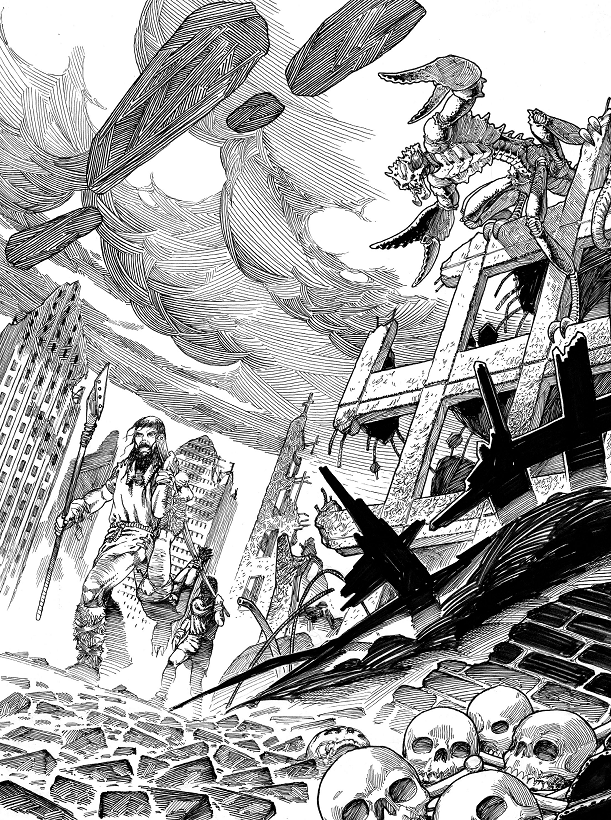
What's up with the sky?
Other Dust creature creation follows the same rules as Stars Without Number: Pick a generic stablock based on the creature's role and then tweak and reskin it to your liking. The statblocks in question are the same as in SWN - except that the "Party-Butchering Hell Beast" (10 HD, AC 2, three 1d8 attacks at +12, unshakable morale) is now called "Eater of Tribes", which is a clear downgrade in my book.
The only new stuff found involves guidelines for how many rations and parts (for very primitive tools, weapons and clothing) you can get out of a dead creature.
Since the setting is centered around a single planet this time around, the list of premade critters is larger and offers more fluff, and they seem to take more liberties from the statblocks (or change more stuff around).
Beastfolk
These guys are the result of Highshine nanites running their wildlife preservation routine on humans, creating a whole line of animal/man hybrids. They still retain human intellect and culture, but their perception is heavily warped by their animal instict, leaving few groups of Beastfolk to develop beyond a primitive tribal structure.
It is perfectly possible for a PC to be one of the Beastfolk, and each of the types of Beastfolk described in this section list the combined worth of their racial abilities in mutation points. They also have attribtue modifiers, though those change the attribute bonus, not the actual score.
The example Beastfolk are Antmen , Boarmen , Bullmen , Crowmen , Fishmen and Wolfmen , all falling between 1 and 2 HD (though PCs from a 2 HD Beastfolk still only start with 1 HD) and having one natural attack and hands to carry proper weapons.
The Crowmen might sound OP since they can fly freely, but the book explains that flight requires too much concentration to attack at the same time. They also can't hover and have to continously move to stay in the air. And flying while encumbered or wearing power armor is of course right out of the question. They are also no Tengu and therefore aren't master swordsmen.
Black Dust
Black Dust is a general term for any nanite swarm that wasn't as lucky as the Higshine, usually taking on the appearance of a black cloud or faint shadow moving through the air. Exposure to Black Dust can have a variety of nasty effects, from damage to radiation up to direct mutations.
Blinder Bird (HD 1-1)
Heavily-mutated owls with nanite-sharpened beaks and talons, these pesky little buggers are particularly good at surprising potential prey, chipping away at its health with 1d4 damage attacks.
Cultists of the Crazed
This section comes with two statblocks for a typical Cult Warrior and Adepts. Both are your typical 1 HD humanoids, though Adepts have a rather beefy +6 to attack.
This section also finally lists who the Crazed are:
-
The Defiler, She Who Remains
: Also known as the Still Lady (and formely known as Fujiko Nakagawa), she's pretty talented in biopsionics and has created herself a floating island out of her
living worshippers
(which the Bright Mirror defensive system doesn't shoot down because its not programmed to go against flying organic "creatures"). There's a free supplement with more detail on her and her cult, but it seems she's the go-to address for gross Japanese body horror.
-
The Usurper, He Who Commands
: He is Jason Williamson, a telepath who believes that everyone is actually dead and in hell. He tries to create some kind of order in this supposed afterlife, but his own followers tend to disappoint him quickly.
-
The Bender, She Who Ruins
: Aka Letitia Somoza, master telekinetic and nano-hacker. She is single-handedly responsible for all the nasty mutations going on. She believes that the Maestros (and AI in general) caused the Scream and will stop at nothing to finish her "ethnic" cleansing.
-
The Saltatrix, She Who Dances
: Leelavathi Chandrasekhar, a teleporter obsessed with movement. Her cultists never stay in one place and a constantly travelling and pillaging across the wasteland.
- The Wraith, He Who Sees : Solomon Nkwame was a criminal before the Scream, and his prison cell's psionic-dampening field seems to have either protected him from the Scream's effect completely, or at least shielded him from its worst effects. In any case, he is the most sane psychic on the whole planet, and he's actively training potential psychics to help him take out the above lunatics for control over Earth. Whether he does this for selfish reasons or for the Greater Good is anyones guess.
The standard mode of operation for the Crazed and their cult involves offering protection to neighboring communities and enclaves, after which things typically go down the shitter. There is also no real global cult network, and most cultist cells operate on their own without their Crazed particularly caring what they're doing.
Flaysnake (3 HD)
A man-sized rattlesnake whose mutation left it without scales and in a constant state of torment. Its poison forces a Saving Throw each round for 2 rounds, dealing 1d6 CON damage per failure.
Ghoul Bear (4 HD)
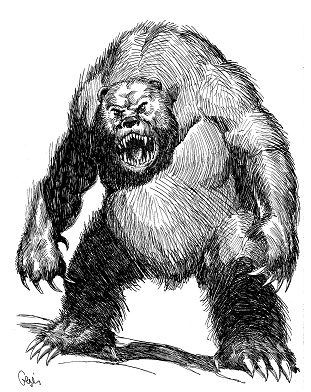
Large and highly-intelligent bears with a somewhat humanesque head. Their name stems from their preference for rotten meat, though they go for fresh meat first if given the choice.
To help them in their hunt for fresh food, they have a mutation that allows them to perfectly mimic the voices of their former victims. This power has a slightly hypnotic effect and can Daze their prey.
Glow Turtle (5 HD)
Very aggressive, man-sized turtles that eat any organic substance they can come across. They are completely immune against radiation, poison and Black Dust, allowing them to accumulate enough radiation to actually glow (hence the name) and become a walking source of radiation.
Gore Hound (1 HD, 3 HD for the alpha)
Wild dogs intelligent enough to troll their prey in sadistic ways. It is unclear whether they are actually mutated or just savage denizens of Old Terra's advanced dog breeds.
Grinder Worm (5 HD)
These are pretty much Graboids with a more realistic worm head. I hope you have explosives.
Gut Weasel (3 HD)
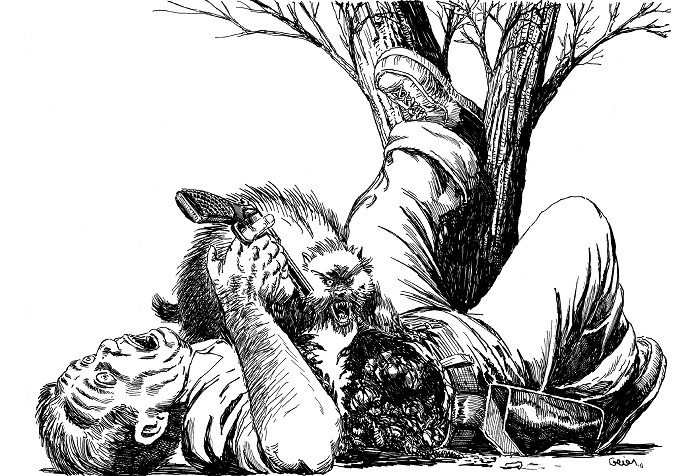
That's one mean weasel.
These lovely critters are wolverines on steroids, digging into prey with their diamond-hard claws (2 attacks +6 with 1d6 damage each) to get themselves nutrients their own body can't produce. Good thing they don't appear in packs.
Heritor Bug (1 HP)
Large cockroaches living in radiated regions. What they lack in endurance they make up for with numbers (a typical group consists of 3d6 of them, and the entire lair has 1d20 x 20).
Humans
Just your typical collection of combat and non-combat post-apocalyptic dudes. Humans with class levels are called Wanderers .
Manscorpion (5 HD)
The dude from the opening picture. Their poison causes DEX damage, which can paralyze its victim.
Psychics (3 or 8 HD)
Since proper psychic training is hard to come by these days outside of a cult, a lot of people with psychic potential actually refuse to use their powers, as they run the risk of brain damage that can either kill them or drive them insane.
The book recommends to look up SWN for the full psychic rules, but you can also just use mutations and abilities presented in this section.
Redhorn (3 HD)
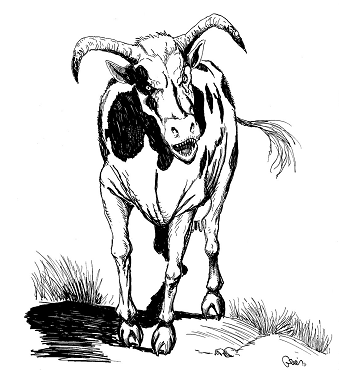
This breed of killer cattle is the result of a more useful strain of the Higshine, which adapted and improved its target for the post-apocalyptic landscape. Redhorns are carnivorous, intelligent and very mean-spirited bovines with fangs and claws (giving them 4 natural attacks). They love hiding among ordinary cattle and are known to actually herd them like humans do.
Robot (8 - 60 HP)
Typical robot bodies ranging from a Companion Bot to the mighty Warbot. They are either controlled by an AI or an Expert System (aka software that is kinda dumb and helpless in situations that are not part of its programming). There are also rules for building them yourself.
Skewman (1 HD)
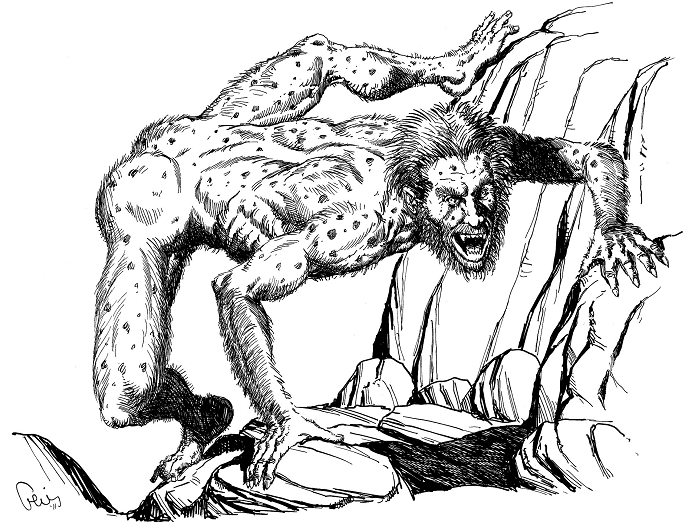
"Hi~..."
Skewmen are the product of a very persistent mutation strain that leaves the joints twisted and unable to support upright movement, in addition to a cosmetic mutation or two. They usualy can't use weapons other than a primitive club, and they have deep hatred for the "upright".
Whiskered Devil (2 HD, 5 HD for alphas)
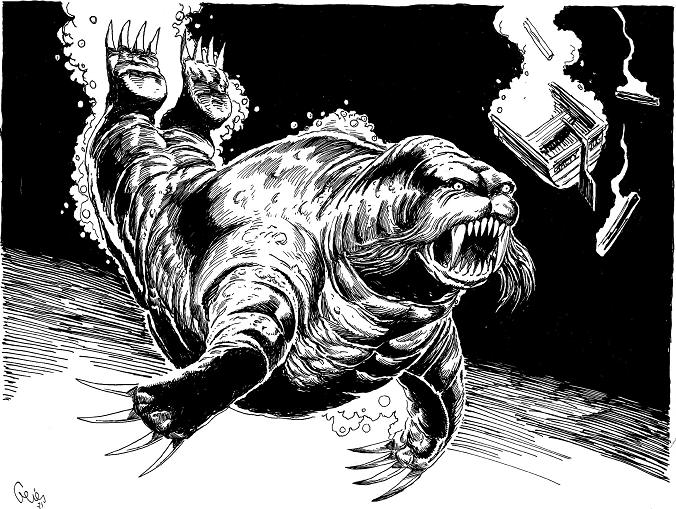
Savage walruses roaming the coasts of New Earth, usually led by a much more intelligent alpha. Rumors persist of packs that have developed some kind of culture and keep humans as slaves.
Next Time: I dunno. Next chapter's about "The Bonelands" aka "The Post-Apocalyptic Northeast" (or rather a possible version; the book doesn't hardcode it as canon), and after that we have the typical SWN-style charts and tables for the GM. Should I tackel the Bonelands, or should I start with The Dark Eye already?
Post 8
Original SA postoriongates posted:
Well, at least they don't dwell on the potentialthat is hyena genitalia. You'd think that would go without saying, but it is a Changing Breeds book...
Imagine a hypothetical Brucato draft of this chapter...
Other Dust

The Bonelands
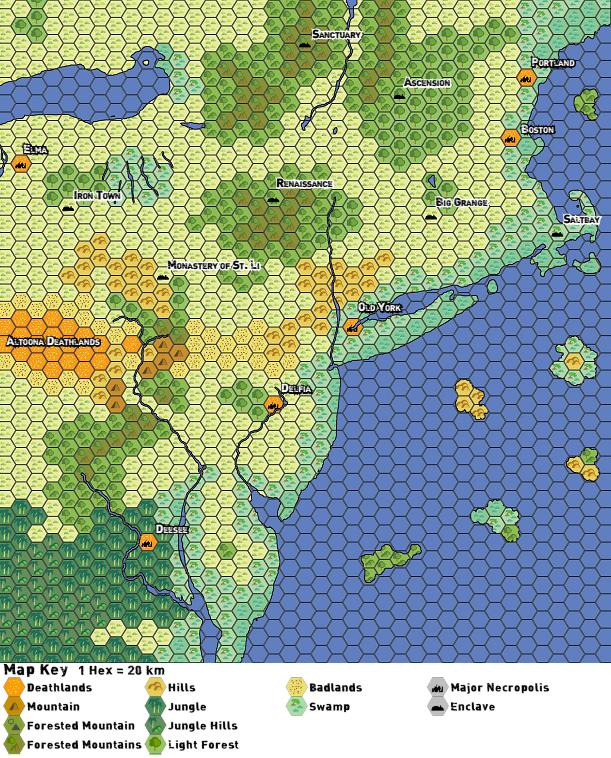
You know, there's quite a lot of green compared to your typical post-apocalyptic wasteland
The Bonelands are one of many possible versions of the American northeast, offering an example sandbox setting to use as inspiration or as is. The map is available as a full-color version with all enclaves and dungeons present, and a printer-friendly black-and-white version without those details for the players.
The northeast of the future offers such lovely locations as the heavily-radiated Altoona Deathlands (which also contaminated just about everything east from it, including the ruins of Old York), the ancient metropolis of "Deesee" inside a dense jungle that is the result of climate change, and the entire coast region having been turned into a mutant-infested swampland called the "Big Sink". Also present are a couple craters from orbital strikes.
If you think the forests in the north have it any better, the various mutants and predators will tell you otherwise.
On the positive side, the Crazed and their cults are only a minor issue in this region.
Enclaves presented here are limited to Polities (aka your standard town/village whatever), with no enclave being at tier 3 and therefore strong enough to be a major player in the entire region. Let's see how much variation you can have with a single type.
Ascension (Tier 2, TL1)
A former resort in the north taken over by a lesser Crazed. Still sane enough to train psychics, but with some weird delusions of godhood, he established a psychic eugenics program were the impure are used as slaves.
This lesser Crazed however didn't quite have the longevity as the setting's major Crazed and died about a 100 years ago. The general consensus of the ruling caste is that he was a bit of a nutjob, but they continue his eugenics program anyways to increase the chances of newborn with the psychic potential. This allowed Ascension to have one of the highest concentration of psychics (with around 60 among the 14,000 people living there), but all the inbreeding has resulted in just about all of these psychics to be crippled in some way, with several infants so misshapen the're used as pig fodder. To get some fresh psychic blood and DNA, the rulers are planning to just kidnap any outside psychic they can get their hands on.
(With the inbreeding going on, this could also work as a Family, but those don't have a huge slave population)
Statwise, Ascension is right in the middle of tier 2, with plenty Food and Influence, but little Moral and Tech. The enclave also has some hefty problems with raiders, slave unrest and fanatic nutjobs.
From a sandbox perspective, if the heroes don't wreck this place, it will probably fall apart on its own. Unless the psychics find a way to replace their useless bodies with robots.
Big Grange (Tier 1, TL0)
A former factory farm populated by refugees from Old York. They found some keycodes that allowed them to use the farm without alerting the security bot. They are in dire need of a scrapsmith or general tech guy, and the mutant raids from the nearby swamps lef them with a hatred for mutants, going so far as to exile their own people if they show signs of mutation.
Overall, it's dumb luck these guys are still around. There's a certain "Help us, player characters!" atmosphere going on.
Iron Town (Tier 1, TL2)
Originally an economically-questionable, non-automated "traditional" factory whose workers simply took over the place after the Scream, ruled by the family of the Foreman.
Thanks to the factory and their know-how, the people of Iron Town are the most advanced in the whole region, enjoying hot water and electricity. They could easily rank up to 2nd tier if they could find more food.
They also face raider-related problems, and there's always a lack of materials and other problems with the factory.
The Monastery of St. Li (Tier 1, TL1)
Descending from refugees who survived in a monastery, this little theocracy found out that its nanite-infested spring had healing properties. This unfortunately led to the nearby enclave of Renaissance effectively taking over the place, milking the monastery while keeping the population in check. There's also some infighting between the different clans of this place.
This enclave is easily the weakest around. Its almost at the lowest Tier 1 can get, and their Ruin is relatively high. Renaissance could easily crush the place completely if they wanted to.
Renaissance (Tier 2, TL1)
Speaking of Renaissance, the place is a former rebel base, whose population is now seeking to restore the golden age before the Mandate became a bit nuts. They ironically employ Mandate tactics, forcing themselves on other enclaves and disposing of anyone who doesn't want to bow down to their commander. More harmless people that don't quite get their ideological message are made into slaves.
Renaissance is easily the most powerful enclave around, with a huge army and just a bit of technology away from becoming a Tier 3 powerhouse. Their biggest problems are internally, namely slave unrest and communist-style purges.
Saltbay (Tier 2, TL0)
And old port town now under mutant rule, the population's ancestors survived the Scream thanks to lots of rations and an underground tunnel system. A nearby nuke however attracted a big Higshine swarm and mutated just about everyone.
The place is no a major trading point in the region, though the mutants running the place can't quite decide on whether or not they should indulge in some conquering.
The enclave is in the middle of Tier 2, with problems mostly centering around human raiders and the occasionaly sea monster.
Sanctuary (Tier 1, TL1)
An abandoned resort village made into an enclave by former slaves who fled from Ascension 100 years ago (using the chaos created by their ruler's death). They organize raids against their former masters and try to flee other slaves, but their lack of food means they won't actually help a freed slave who can't contribute to their society.
Aside form the lack of food, they're in quite a good positon for a Tier 1 enclave, with barely any major problems.
Notable Ruines
A couple potentional dungeon locations, including a cave full of degenerated mutants, a power plant populated by man/plant-hybrids, and a former educational center whose power core will probably have a meltdown in the near future.
The chapter then ends with a bunch of random encounter tables for the various sub-regions and places.
Next Time : I'll probably tackle SIlent Legions (aka "OSR Call of Cthulhu that replaces the Cthulhu mythos with a randomly-created one") in the foreseeable future, but first I gotta do some Dark Eye.